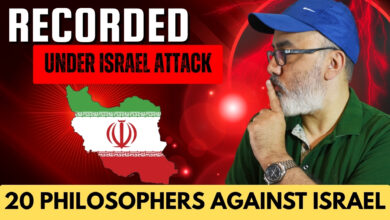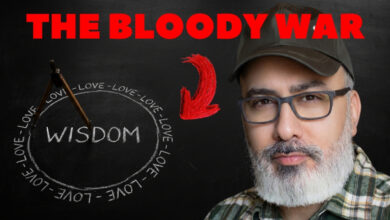Israel and the United States Attacked Iran for this one Reason
Iran-Israel-war
Why Did Israel and the United States Attack Iran? A Historical and Strategic Analysis
In recent times, the world has witnessed a dramatic escalation in tensions between Iran, Israel, and the United States, culminating in military strikes against Iran. These attacks have sparked widespread debate about the underlying reasons for such actions and their implications for the Middle East and beyond. This article provides an in-depth examination of the conflict, exploring the historical roots, strategic motivations, and cultural perspectives that shed light on why Israel and the United States targeted Iran. Drawing on a poem by the 13th-century Persian poet Rumi, we also reflect on the timeless nature of such conflicts and their consequences.
Introduction: The Escalation of a Long-Standing Conflict
The military strikes on Iran by Israel and the United States represent a significant moment in an ongoing geopolitical struggle. For decades, Iran has been a focal point of contention due to its strategic location, vast natural resources, and assertive foreign policy. Israel and the United States, driven by security concerns and regional ambitions, have viewed Iran’s rise as a threat to their interests. The recent attacks, however, mark a shift from diplomatic posturing to direct military engagement, raising questions about the true objectives behind this escalation.
What prompted Israel and the United States to take such drastic measures? Was it solely about Iran’s alleged nuclear ambitions, or do economic and geopolitical factors play a larger role? Furthermore, how does Iran’s resilience and unity influence the outcome of this conflict? To answer these questions, we must first examine the historical context that has shaped the relationships between these nations.
Historical Context: Decades of Tension and Warfare
The animosity between Iran, Israel, and the United States is deeply rooted in historical events, beginning with the 1979 Islamic Revolution in Iran. This pivotal moment saw the overthrow of the U.S.-backed Shah and the establishment of an Islamic Republic under Ayatollah Khomeini. The revolution transformed Iran from an ally into an adversary of both Israel and the United States, setting the stage for decades of hostility.
The Iran-Iraq War: A Test of Resilience
One of the most formative events in Iran’s modern history was the Iran-Iraq War (1980-1988). Iraq, led by Saddam Hussein and supported by Western nations including the United States, France, and Germany, invaded Iran in an attempt to weaken the newly established Islamic Republic. The war was marked by extreme brutality, including Iraq’s use of chemical weapons—supplied by Germany—against Iranian soldiers and civilians, as well as the massacre in Halabja, an Iraqi Kurdish city.
Despite facing overwhelming odds and international isolation, Iran endured eight years of war, emerging with its sovereignty intact. The conflict ended with United Nations Resolution 598, which held Saddam Hussein accountable for initiating the war. This period demonstrated Iran’s capacity to withstand aggression, a trait that continues to define its response to external threats.
The Nuclear Controversy: A Persistent Divide
In the years following the Iran-Iraq War, Iran’s nuclear program became a central issue in its relations with Israel and the United States. Both nations have accused Iran of pursuing nuclear weapons, a claim Iran has consistently denied, asserting that its program is intended for peaceful energy production. The International Atomic Energy Agency (IAEA) has found no conclusive evidence of a weapons program, and Iran remains a signatory to the Nuclear Non-Proliferation Treaty (NPT), which prohibits it from developing nuclear arms.
In contrast, Israel, which is not a member of the NPT, is widely believed to possess an undeclared nuclear arsenal. This disparity has fueled Iran’s criticism of what it perceives as double standards in international policy. The nuclear question has remained a flashpoint, with Israel and the United States citing it as a justification for their aggressive stance toward Iran.
Regional Rivalries and Proxy Conflicts
Iran’s influence in the Middle East has also contributed to its tensions with Israel and the United States. Through its support for groups like Hezbollah in Lebanon and Hamas in Gaza, Iran has extended its reach, challenging Israeli and American dominance in the region. These organizations, labeled as terrorist groups by Israel and the U.S., have received funding and weapons from Iran, enabling them to engage in conflicts that threaten Israeli security.
Additionally, Iran’s alliances with Syria and the Houthi rebels in Yemen have further solidified its position as a regional power. This growing influence has alarmed Israel and its allies, who see Iran’s actions as destabilizing and a direct threat to their interests.
The Recent Attacks: Unpacking the Motivations
The military strikes on Iran by Israel and the United States were not impulsive decisions but the culmination of years of strategic planning and escalating tensions. Several key factors drove this decision, reflecting a mix of security, economic, and political objectives.
1. The Nuclear Threat Narrative
The most frequently cited reason for the attacks is Iran’s nuclear program. Israel, in particular, views a nuclear-armed Iran as an existential threat. Prime Minister Benjamin Netanyahu has long advocated for preemptive action to disrupt Iran’s nuclear capabilities, arguing that diplomacy alone cannot prevent Iran from achieving its goals. Reports of advancements in Iran’s uranium enrichment process, combined with IAEA criticisms of Iran’s transparency, provided a pretext for military intervention.
The strikes targeted facilities believed to be linked to Iran’s nuclear infrastructure, aiming to set back its progress and send a warning about future developments. However, the lack of definitive evidence of a weapons program raises questions about whether this justification masks other motives.
2. Economic Interests and Resource Wealth
Iran’s immense natural wealth is another critical factor in the conflict. The country holds over 9% of the world’s natural resources, including vast reserves of oil, natural gas, and minerals, despite housing less than 1% of the global population. This disparity makes Iran an attractive target for nations seeking to secure or control these assets.
By attacking Iran, Israel and the United States may have aimed to weaken its economic stability, disrupt its ability to export oil and gas, and limit its financial support for regional allies. The destruction of key infrastructure, such as refineries and military bases, could hinder Iran’s economic resilience, aligning with broader strategic goals of containing its influence.
3. Geopolitical Strategy and Regional Dominance
The Middle East is a theater of intense geopolitical competition, and Iran’s rise as a counterweight to U.S. and Israeli power has not gone unnoticed. Iran’s partnerships with Russia and China, as well as its support for anti-Western factions, position it as a challenge to the established order. The attacks can be seen as an attempt to reassert dominance in the region and deter other nations from aligning with Iran.
Furthermore, the strikes may have been intended to bolster Israel’s position among its Arab allies, such as Saudi Arabia and the United Arab Emirates, who share concerns about Iran’s growing power. For the United States, supporting Israel reinforces its role as a key player in Middle Eastern affairs.
4. Political Pressures at Home
Domestic politics also played a role in the decision to attack Iran. In Israel, Netanyahu has faced significant challenges, including legal battles and public unrest. A successful military campaign could strengthen his leadership and rally national support. Similarly, in the United States, President Donald Trump has sought to project strength and decisiveness, particularly in an election year. The attacks offered an opportunity to appeal to voters and demonstrate resolve against a long-standing adversary.
Iran’s Response: Strength in Unity and Retaliation
Iran’s reaction to the attacks has been a testament to its resilience and strategic capabilities. Rather than succumbing to pressure, Iran has mounted a robust defense, leveraging its unity, military assets, and regional alliances.
A Nation United
Iran is a diverse country, with ethnic groups such as Persians, Azeris, Kurds, and Arabs coexisting within its borders. Historically, external threats have unified these groups, and the recent attacks have been no exception. Across social media platforms, Iranians have expressed solidarity and defiance, rallying behind their government and military in the face of aggression.
This unity has confounded the expectations of Israel and the United States, who may have anticipated internal dissent or collapse. Instead, the strikes have strengthened Iran’s national resolve, echoing the spirit of resistance seen during the Iran-Iraq War.
Military Prowess and Counterstrikes
Iran’s military response has been swift and effective. Despite facing technologically superior adversaries, Iran has utilized its missile capabilities to launch retaliatory strikes against Israeli and U.S. targets. Hundreds of missiles and drones have been deployed, overwhelming Israel’s advanced air defense systems and causing significant damage.
This demonstration of military strength highlights Iran’s advancements in missile technology and its ability to deter further aggression. The attacks have also exposed vulnerabilities in Israel’s defenses, challenging the notion of its invincibility.
Rumi’s Poetry: A Lens on Power and Conflict
Amid the turmoil of war, the words of Rumi, a 13th-century Persian poet, offer a profound perspective on the current crisis. In one of his poems, Rumi writes:
Feathers became the peacock’s bitter foe
And kings were killed by their own love of show.
He said, ‘I’m like the deer for whose musk scent
Hunters desire to catch and then torment;
The desert fox, which when they capture her,
They chop her head off just to keep the fur;
That elephant who’s beaten savagely,
They shed his blood just for his ivory,
Those who would kill for secondary goals
Should know I’ll take my vengeance on their souls,
I’m now the victim, your turn’s coming soon,
Those hungry for my blood are not immune!
This poem, written over 800 years ago, resonates with the conflict between Iran, Israel, and the United States. The “hunters” symbolize the aggressors—Israel and the United States—driven by a desire to exploit Iran’s wealth and strategic value, represented by the “deer,” “fox,” and “elephant.” Rumi’s warning that the pursuit of superficial gains leads to retribution mirrors Iran’s defiance and the potential consequences for its attackers.
Interpreting Rumi in the Modern Context
Rumi’s poetry underscores the cyclical nature of conflict and the dangers of greed. Israel and the United States may have aimed to weaken Iran, but the poem suggests that such actions sow the seeds of their own downfall. Iran’s resilience and counterattacks align with Rumi’s assertion that victims of aggression will not remain passive. The poem challenges the moral basis of the attacks, questioning whether the pursuit of power and resources justifies the cost in human lives and regional stability.
The Wider Implications: A Region at Risk
The attacks on Iran have set off a chain reaction with profound implications for the Middle East and the global community. The conflict has drawn in other powers, heightened economic uncertainty, and exacerbated humanitarian suffering.
Escalation and Regional Instability
The involvement of Iran’s allies, such as Russia and China, and the support of Gulf states for Israel and the U.S., threaten to escalate the conflict into a broader war. The use of proxy groups adds complexity, increasing the likelihood of miscalculation and further violence. If unchecked, this could destabilize the entire region, with ripple effects felt worldwide.
Economic Fallout
Iran’s role as a major oil producer means that the conflict has significant economic repercussions. Damage to its oil infrastructure and the potential closure of the Strait of Hormuz—a critical chokepoint for global oil shipments—could drive up energy prices and disrupt supply chains. The uncertainty has already caused volatility in financial markets, with long-term consequences still unfolding.
Humanitarian Crisis
The human cost of the attacks is staggering. Hundreds have been killed or injured, and critical infrastructure, including hospitals and schools, has been destroyed. Displacement has surged, particularly in border areas, and the United Nations has warned of an impending humanitarian crisis. The international community faces the challenge of providing aid in a volatile environment.
Conclusion: Toward Dialogue, Not Destruction
The military strikes on Iran by Israel and the United States have illuminated the complexities of a conflict driven by history, strategy, and ideology. While the stated goal may have been to neutralize a perceived threat, the attacks have instead revealed Iran’s strength and the limits of military power. Rumi’s poetry serves as a timeless reminder that wars fought for dominance often lead to mutual ruin.
As the world watches this unfolding crisis, the need for diplomacy has never been greater. History—from Vietnam to Afghanistan to Iraq—shows that military solutions rarely achieve lasting peace. For Iran, Israel, and the United States, the path forward lies in dialogue and mutual understanding, not in the perpetuation of war.







